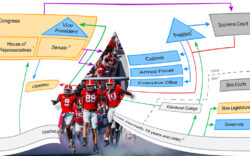Hamilton Holmes wanted to attend UGA so that he’d have a shot at getting into medical school at Emory. Charlayne Hunter needed UGA’s Grady College so that she could realize her dream of becoming a reporter. Just two Georgia kids who knew where they wanted to go and knew their state university was the ticket to get them there.
But that was in 1961, and Georgians of color could not attend the University of Georgia, even though UGA leaders swore in federal court that it was just mere coincidence that no Black students (except some foreigners) had ever attended the school.
So Hamilton and Charlayne’s lawyers went to court and easily proved, thanks to federal judges who applied the law impartially, that they were entitled to attend the state’s “flagship” university. Their admittance demanded great perseverance, and their attendance required great courage.The average white kid from Hahira had only to graduate from high school, apply to Georgia, sit for the interview that confirmed their basic whiteness and come on up to Athens to let the good times roll.
Calvin Trillin’s book An Education in Georgia (reprinted by UGA Press) tells the story of what it was like for Charlayne Hunter (now Hunter-Gault) and Hamilton Holmes to become the first Black students here 60 years ago—an anniversary marked recently by several events at the university and by photographic and memorabilia exhibits still up at the Main Library and the Special Collections Library. For an even closer look at Charlayne’s life on campus, see Joan Zitzelman’s memoir in the current Athens Historian, a publication of the Athens Historical Society, and tune in Thursday, Feb. 4 at 4 p.m. for a conversation between Hunter-Gault and Trillin about UGA integration (ugapress.org/kick-off-event-an-education-in-georgia-then-and-now/).
In a minor key, the integration of the University of Georgia followed the same trajectory as the recent storming of the U.S. Capitol: the big lie, the sham court cases, the posturing politicians, the press frenzy, the attempts to nullify the law by direct action, the long and drawn-out rear-guard resistance.
At that time, like any good Southern moderate, I was trying to stay in the good graces of my gun-totin’ fraternity while doing what I could with a group working to counter the Confederate flag-waving crowds eager to perform in front of the TV cameras. We wrote and distributed leaflets calling on students to abide by the law. Then, when it appeared that the legislature was going to shut down the university, we got the signatures of a third of the student body on a petition calling for the university to remain open in spite of integration. We delivered the petition to the legislative leadership, who were also working to avoid closing the school, and that crisis passed.
Meanwhile, back on campus, a cadre of politically ambitious law students was orchestrating a direct assault on Myers Hall, where Charlayne Hunter was lodged, segregated from the other students in the dorm.
Our group attached ourselves to Trillin, then just out of Yale and covering the events for Time magazine. At the end of each of those long days, we gathered in his room at the Holiday Inn to pump him full of our moderate views in hopes of making UGA look better in the national press.
We were doing OK until the night of the riot outside Myers, when the angry mob surged back and forth and the rocks and the tear gas flew, while the governor delayed sending the state patrol. From his firsthand, pissed-off observations that night, Trillin concluded that the mob would have stormed Myers Hall had it not been for Dean of Men William Tate, practically the only UGA official to act honorably and courageously during that period.
I had seen Tate break up crowds with his jolly act, but I had not until that night personally witnessed the dean’s wrath-of-God persona. He confronted the mob head-on and began demanding ID cards—the kiss of death to your educational future. He broke it up, but UGA used the riot as the excuse for expelling Charlayne and Hamilton “for their own safety.” Dean Tate rode to Atlanta with them, regaling them with stories all the way, and he was waiting for them when the court sent them back to school.
You could say those events of 60 years ago were all in vain. Sure, Charlayne and Hamilton got their degrees and went on to illustrious careers—she in journalism, he in medicine. But the boys in the mob outside Myers that night risked their own education needlessly if they were fighting to keep Black students from taking over UGA.
Other Black students followed Charlayne and Hamilton but have never been more than 10% of the enrollment. The HOPE scholarship came along to help less affluent students attend Georgia colleges—a boon to students of all colors all over Georgia. But the HOPE was quickly amended to drop the $100,000 ceiling on family income and give it to all students with a “B” average. Wealthier families now recognized the scholarship as an offer they could not afford to refuse.
That change altered forever any idea that the University of Georgia would be open to a cross-section of Georgia students. Thus has evolved the modern UGA, focused on “national prominence” and dominated by the better high schools from the affluent Atlanta suburbs, which generally outperform those in the rest of the state and crowd out other students. Black kids are admitted, as are some other students from outside the metro areas, but 60 years after integration, the result has been sort of like the outcome of the Civil War in Georgia: We won some skirmishes, but all those Yankees around Atlanta came out on top.
Like what you just read? Support Flagpole by making a donation today. Every dollar you give helps fund our ongoing mission to provide Athens with quality, independent journalism.










